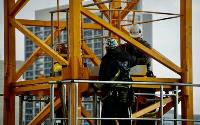 Add My Company
Add My Company
Sign In

The dangers of working from heights have been around for centuries. As people risk their lives to complete tasks and reach inaccessible places. Either from lofty platforms, elevated structures, aerial vehicles, or other raised elevations. From ancient civilisations to modern times, the challenge of working at height has been met with a variety of approaches.
In the ancient world, scaffolding was used to provide workers with platforms for painting, construction, and other labour at heights. This was often hazardous, as ladders are not always secure, and scaffolding could be unstable. This meant that workers were at risk of serious injury if they fell or if the ladder or structure, they were working on collapsed. Furthermore, these methods typically lacked the necessary safety measures to protect workers, such as guardrails and safety nets.
Egyptians in particular were known to use makeshift wooden scaffolds to complete construction projects throughout the region. While simple in structure, these wooden ladders were effective for working at height and allowed workers to complete projects such as constructing the pyramids.
However, the way people work from heights has changed significantly over the years. With the use of electric scissor lifts, aerial lifts, booms, cherry pickers, and other machinery has become commonplace for working at height. This machinery has enabled workers to access otherwise hard-to-reach areas, making construction and repairs much easier and faster.
Advanced Solutions
there are many technologically advanced solutions that make working from heights safer and more efficient. For example, advances in suspension systems have allowed workers to use less intrusive and hazardous methods of access. Systems like suspended platforms, cable cars, and aerial lifts. These methods allow workers to access dangerous heights without having to climb ladders or use scaffolding.
Safety Regulations
Furthermore, safety regulations have improved drastically over the years. Ensuring that workers are provided with the necessary protective equipment and are trained on how to use it safely. This includes helmets, safety harnesses, and fall protection systems. This equipment can be worn when using suspension systems to protect workers from coming into contact with dangerous surfaces or falling from height. Training such as IPAF harness training teaches people how to select, inspect and safely use a harness and adjustable lanyard.
Technology
Lastly, many companies are now using drones to conduct dangerous things such as inspecting towers and investigating industrial accidents. Drones offer the advantage of being able to access difficult-to-reach places without putting workers at risk of injury or death. Becoming a cost-effective and practical option for surveying projects and collecting data. For industries such as engineering, construction, and architecture, drones can provide an efficient way to survey building sites and identify various features of a property. Additionally, drones are often used for high-altitude filming, which is especially useful for television and film.
Overall, the way people work from heights has changed dramatically over the years and will continue to evolve. The introduction of safer technologies and protective equipment has made working from heights much less hazardous, which is beneficial for both workers and employers. In the future, new innovations and regulations will continue to improve safety standards even further, ensuring that workers are able to access hard-to-reach places safely and efficiently.
For more information on How Working From A Height Has Changed Over The Years talk to Premier Platforms Ltd
Enquire Now
List your company on FindTheNeedle.
